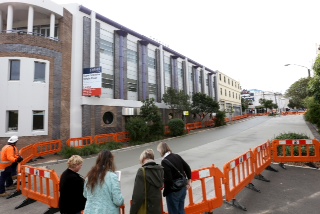Taking the light road to a cooler future
Pale surfaces may pave the way to a cooler future for our cities, with a new City of Sydney trial exploring the potential for light-coloured pavement to reduce temperatures in surrounding areas.
The ‘urban heat island effect’ means cities are often a few degrees warmer than regional areas due to surfaces such as roads, footpaths and buildings absorbing heat from the sun. Lighter-coloured pavements may be one solution to reduce this effect.
The trial will record temperatures across different locations in Chippendale, including a 600-square-metre section of Myrtle Street. Over coming months, monitoring equipment will determine whether or not there is a reduction in ambient temperate along the paler pavement.
Lord Mayor Clover Moore said temperatures in Sydney were expected to rise in coming decades due to the city’s growth and the effects of climate change.
“Our cities are growing rapidly in size and population and our increasing energy consumption, carbon emissions and household waste is straining the natural environment,” the Lord Mayor said.
“The City is taking long-term action to tackle climate change. We are increasing the tree canopy by 50 per cent to cool buildings, reduce power bills and beautify our city and making big investments in renewable energy. We will also continue to test new ideas to make sure we’re being as effective as possible.”
Independent sustainability expert and Chippendale resident, Michael Mobbs, said the trial offers an important opportunity to cool the suburb.
“Materials such as concrete and cement store more heat than natural surfaces, absorbing it during the day and releasing it at night, which can contribute to hotter urban areas,” Mr Mobbs said.
“Black-coloured roads and a lack of tree cover can increase the heat of our cities by up to eight degrees. Lighter coloured pavements may result in lower energy bills for surrounding buildings.”
The composition of the new section of road will include open grade asphalt pavement that will be filled with concrete slurry, providing a lighter texture to the pavement.
The City has an ambitious long-term target of reducing its carbon emissions by 70 per cent and increasing the city’s tree canopy by 50 per cent by 2030.
It has introduced a range of measures to achieve this, including planting thousands of trees, introducing energy-efficient LED lighting, installing solar panels across buildings, retrofitting buildings to improve energy efficiency, and harvesting and treating stormwater for a cleaner environment.
For media inquiries or images, contact City of Sydney Senior Media Adviser Claire Thompson.
Phone 0408 414 376 or email [email protected]
For interviews with Lord Mayor Clover Moore, contact Jonathon Larkin.
Phone 0477 310 149 or email [email protected]
loading...
loading...
Tags: City of Sydney




Voices of our community